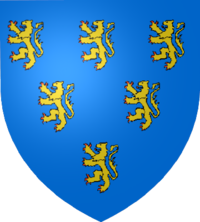House of Plantagenet
From Wikipedia, the free encyclopedia
The House of Plantagenet (IPA: [plan└ÓtadáÝŐünŐüt]), also called the House of Anjou, was originally a noble family from France, which ruled the County of Anjou. They later came to rule the Kingdom of England (1154ĺ─ý1485), as well as Jerusalem (1131ĺ─ý1205), Normandy (1144ĺ─ý1204 and 1415ĺ─ý1450), and Gascony and Guyenne (1153ĺ─ý1453).
The House of Anjou was a cadet branch of the original Counts of Anjou, the dynasty established by Fulk I of Anjou at the beginning of the 10th century. That dynasty becoming extinct in the male line in 1060, with the death of Geoffrey Greymantle, the Anjou domains were inherited by his nephew Geoffrey, son of Ermenegarde of Anjou and Geoffrey, Count of Głótinais. The House of Głótinais, ruling over Anjou, thus became the House of Anjou, and by the early 12th century had also secured Maine.
In the 11th century, the House of Anjou was one of the four main dynasties in northern France: the other three being the House of Blois (which ruled over Blois and Champagne); the Dukes of Normandy (who ruled over the Duchy of Normandy); and the royal house itself, the House of Capet, which controlled personal possessions in the Ile-de-France, and exercised a theoretical authority over all of feudal France. Out of these four, the House of Anjou was third-most important, superior only to the poor and badly situated Normandy; the Angevins were considered unruly and the Counts demonstrably unstable: Fulk III of Anjou notoriously had his first wife burnt to death in her wedding dress to punish her for adultery. The Angevins became inferior even to the Normans after the Duke of Normandy, William, became King of England.
In 1128, Geoffrey Plante Genest (Plantagenet), count of Anjou married William's granddaughter, Matilda, giving birth to Henry who, largely through his parents' efforts, obtained the English crown in 1154. This became the first royal Angevin dynasty, known from the 12th century as the Plantagenet dynasty in England. It thereby came (with its Lancastrian and Yorkist branches) to rule, but lost Anjou itself to the French crown in 1206.

The name "Plantagenet" was originally spelled Plante Genest or Plantegenest or Plantaginet.[1] It is derived from the broom plant (planta genesta). It originated with Geoffrey of Anjou, father of King Henry II of England; it is most commonly claimed that it arose because he wore a sprig of it in his bonnet[2] though perhaps otherwise that he planted broom to improve his hunting covers.[3]. Its significance has been said to relate either to its golden flower[4] or to contemporary belief in the vegetable soul.[5]
The surname "Plantagenłüt" has been retroactively applied to the descendants of Geoffrey of Anjou as they had used no surname. The first descendant of Geoffrey to use the surname was Richard Plantagenet, Duke of York, father of both Edward IV and Richard III, who apparently assumed it about 1448. That said, it has been traditional when referring to the Plantagenets to call all descendants of Geoffrey by this surname.[6]
The family became extinct in the legitimate male line with the execution of Edward, Earl of Warwick, the nephew of Edward IV and Richard III, in 1499. The last legitimate female Plantagenłüt was his sister, Margaret Pole, 8th Countess of Salisbury, who was executed by Henry VIII in 1541.
A notable illegitimate line of the family were the Beauforts, descendants of John of Gaunt by his mistress, Katherine Swynford. The Beauforts held the title of Duke of Somerset and were one of the prominent Lancastrian families in the Wars of the Roses. Although the Beauforts became extinct in the male line in 1471, it was through them, on his mother's side, that Henry Tudor claimed the English throne. In Colonial America Anne Brent, the wife of Leonard Calvert, also descended from this line (Plantagenłüt - Beaufort - Neville - Willoughby - Greville - Reed - Brent).
An illegitimate branch of the Beauforts, descended from an illegitimate son of Henry Beaufort, 3rd Duke of Somerset, survives to the present day, bearing the surname "Somerset" and the titles Duke of Beaufort and Lord Raglan.
[edit] References
- ^ J.S.Plant (2007) "The tardy adoption of the Plantagenet surname", to appear in Nomina, Vol. 30
- ^ e.g. The Complete Peerage, vol. 11 ed. G.H. White (London, 1949), Appendix G, pp. 140-41, note(e)
- ^ Encylopedia Britannica, editions from 1974 onwards
- ^ J. Bradbury in Studies in Medieval History presented to R. Allen Brown (Boydell Press, 1989), pp. 27-41, esp. p. 40
- ^ J.S. Plant (2005) Nomina, 28, pp. 115-33, esp. pp. 120-21, 128
- ^ The Complete Peerage, 2nd edn., vol. 1, p. 183, note (c)
| House of Plantagenet | ||
|---|---|---|
| Preceded by House of Capet |
Ruling House of the Duchy of Aquitaine 1152ĺ─ý1399 |
Succeeded by House of Lancaster |
| Preceded by House of Normandy |
Ruling House of the Kingdom of England 1154ĺ─ý1399 |
|
| Ruling House of the Duchy of Normandy 1154ĺ─ý1204 |
Succeeded by House of Capet Merged into the Kingdom of France |
|


